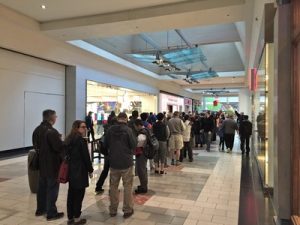The Black Friday Weekend Results Are In!


We have reached the end of the wonderful four-day shopping-spree known as Black Friday weekend. Retailers spend months planning advertisements and sales ideas to bring in as much revenue as possible, just for these four days! As explained in one of our previous blogs, Black Friday Trends in Past Years, the Black Friday weekend kicks off the holiday shopping season; companies have all sorts of deals to get consumers excited and eager to buy products both in-store and from their e-commerce websites.
Now that the 2018 Black Friday weekend has come to a close, let’s review the results and reasons for the outcomes!
Black Friday’s Shift From On-Line to Online
Overall Black Friday weekend 2018 was extremely successful. The weekend sales totaled about $60 billion, which was the strongest growth since 2011 and a 6% increase over the last year. It seemed that across the board, traffic on Thursday evening was really good, somewhat slower on Friday morning, stronger Friday afternoon, and regular on Saturday and Sunday and strong once again on Monday.
As predicted, the most sought-after items were consumer electronics and appliances, whose sales rose 6.4%. The online sales that Cyber Monday brought in was roughly $7.8 billion, making it the biggest online shopping day in U.S. history. From this statistic, it is apparent that Black Friday isn’t quite what it used to be.
Reports from over 400 retail stores say that in-store sales have dropped by as much as 7% while in-store traffic was down 5% to 9% in the fourth straight year. But there is still hope for brick-and-mortar stores; consumers are still rushing to stores and waiting outside for hours to receive the doorbuster deals, even with having the second coldest Thanksgiving in New York City since 1901.


It is estimated that about 151 million people visited some form of a shopping center over the weekend, which shows that consumers are still interested in the experience that Black Friday brings. Retail stores appear to be trying to reinvent themselves as more customer-centric to continue to show that are still relevant in today’s online world.
An example of this can be seen with Walmart, who opened their doors Thanksgiving Day. To coerce customers to come to their physical store, they were handing out 4 million free Keurig coffees and 2 million Christmas-themed cookies starting at 4 p.m. Even so, now that all the shopping can be done from your house, why bother going out? That brings us to the next point: online shopping.
Online Shopping Shows Us the Way
Even though not as many people showed up in-store as they did in previous years, the statistics show that shoppers were still very active. Online Black Friday sales managed to rake in a record-breaking $6.2 billion. To detail it more specifically, online shopping on Thanksgiving Day saw a 28% increase from last year and Black Friday had a 24% increase. Because everything was able to be done online, people were able to cash in on the online sales on Thanksgiving Day, which resulted in over $3.7 billion.
One of the major reasons retailers saw an increase in online sales was due to mobile shopping. The wonderful part about mobile phones is that they are essentially pocket-sized computers and that is exactly what companies are trying to capitalize on. With this, consumers have the ability to make mobile purchases and complete online shopping anywhere they go.
Because of this fact, 33.5% of online sales on Black Friday was from mobile shopping, which was a 29.1% increase from 2017, and Cyber Monday saw more $2 million worth of purchases, or almost 20% of the day’s total revenue, from customer’s phones.


Another huge draw for online shopping that was seen over the weekend was shipping. Many retailers, like Amazon, Target, Walmart, and Macy’s have increased their shipping game. They were trying to utilize all their resources and capitalize on the benefit of having physical and online stores by giving the option for online ordering for store or curbside pick up. From this, in-store pick up skyrocketed 73% on Thursday and Friday, which was a very interesting tactic.
E-commerce Rules Again
Another reason for the surge in online shopping is good e-commerce websites. What this means is simple: that the website is easy to navigate and digest. It is important that segments of the website are organized and are able to guide the user from the home page to checkout with the fewest steps possible. The key to this is UI/UX, or User Interface and User Experience. With proper UI/UX built into the website, it reflects the quality of business, encourages user engagement, and ultimately drives more sales.
Where does proper UI/UX come from you might ask? From expert web development and web design. At eMagid, a professional web development company in NYC, we make it a priority to not just develop websites, but to design them with UI/UX in mind to create the best experience possible for the user.


To take this a step further, now more than ever rises the importance of mobile shopping. Because being mobile allows a customer to complete a purchase anywhere at any time, it is critical to ensure that your website is optimized for the mobile platform. Another area that eMagid specializes in is development for the mobile platform. We spend the extra time to make sure our websites, especially our e-commerce websites, have the capability to properly view and interact with on a mobile device.
To see some examples of our e-commerce websites, check out our Projects page. With professional guidance on your side, it is guaranteed that your company’s e-commerce website will stand out from the rest.
The Holiday Shopping Continues On
Even though the Black Friday shopping weekend is over, the holiday shopping season is just getting started. With the wonderful results from this past weekend, it seems like we are going to a very strong rest of the holiday season. Time will tell how next month’s shopping results will turn out, but the prospect of possibly breaking some more records is quite exciting.
